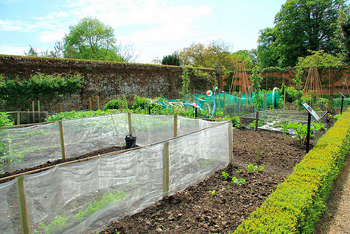
A garden border refers to an area of the garden that creates a border around an area of plants or garden. It is usually designed in a way that it can be viewed from the front and/or sides but it can't be seen from all sides unless you are above it in some way (such as a lookout or atop a staircase).
Garden borders can be planted using a variety of plants, depending on the needs. The most typical border plants used are small to large shrubs (depending on the space available), herbs, flowers (if annual, it is short lived) or a mixed border containing a variety of hardy perennials.
Border types[edit | edit source]

Here is a rundown of the different types of garden borders:
- Shrub border: Shrubs that are low maintenance are often chosen, such as hydrangea or rhododendrons. Care needs to be taken to choose shrubs that are interesting in both flowering and leaf-only stages, to provide year-round interest.
- Herbaceous border: This often backs onto a fence, and is long and narrow in shape.
- Floral border: This consists of flowering bushes, perennial or annual. You might like to consider the flower colours, either using all the same colours or using complementary colours, when choosing the flower plants. Roses, lavender, marigolds and pansies are just a few of the possibilities.
- Mixed border: This usually consists of a mixture of hardy perennial plants. There is no need for conformity in terms of shape, type of plant or colours.
- Mini or small hedge: Small hedges can form a garden border, but may need to be kept trimmed to keep them sufficiently low. Box hedge plants can be useful for a compact hedge that is easy to take care of.
Things to consider[edit | edit source]
When designing a garden border, think about the following things:
- Do you want a permanent border (such as for a garden that is designed to be enjoyed all seasons), or an impermanent border (such as a border designed for temporary display either in your garden or for a garden show)?
- Do you want an ornamental or an edible border? Some edible borders can be perennial (such as rosemary borders), whilst others will be annual, such as a vegetable border.
- Do you want the border to form part of a theme across the garden? If so, shape and colour may be important when selecting the plants or type of border.
Non-planted garden borders[edit | edit source]

Garden borders can also be formed by non-plant materials, depending on the style and needs for your garden. Examples include:
- Brick borders: The bricks are dug into the ground and only the top surface is seen; a good border for a herb garden.
- Rock borders: The rocks are usually above the ground and sorted by size. These can be very interesting if the rocks have been chosen with care. Might suit a rockery garden or a large area garden.
- Wire arches: Small wire arches can form a border around a garden space, with the legs in the soil and the arches facing upward.
- Standing blocks: Small blocks (concrete, etc.), pavers or bricks can be used as a standing border, one that is not flat in the ground but appears like a tiny fence around the garden space. (See image in this section.)